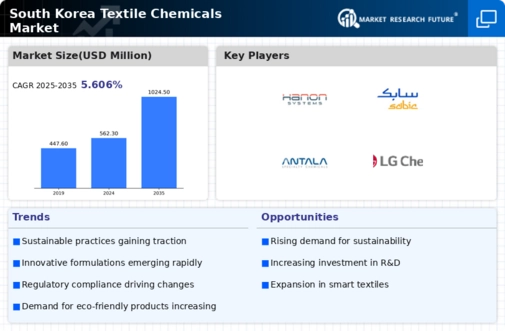The textile chemicals market in South Korea is characterized by a competitive landscape that is increasingly shaped by innovation, sustainability, and strategic partnerships. Key players such as BASF (DE), Huntsman Corporation (US), and Clariant (CH) are actively pursuing strategies that emphasize product development and regional expansion. For instance, BASF (DE) has focused on enhancing its portfolio of sustainable textile chemicals, which aligns with the growing demand for eco-friendly solutions. Huntsman Corporation (US) appears to be leveraging its expertise in specialty chemicals to cater to the evolving needs of the textile industry, while Clariant (CH) is investing in digital transformation initiatives to optimize its operations and improve customer engagement. Collectively, these strategies contribute to a dynamic competitive environment where innovation and sustainability are paramount.
In terms of business tactics, companies are increasingly localizing manufacturing and optimizing supply chains to enhance efficiency and responsiveness to market demands. The market structure is moderately fragmented, with several key players exerting influence over various segments. This fragmentation allows for a diverse range of products and services, fostering competition that drives innovation and quality improvements across the sector.
In October 2025, BASF (DE) announced the launch of a new line of biodegradable textile chemicals aimed at reducing environmental impact. This strategic move not only reinforces BASF's commitment to sustainability but also positions the company as a leader in eco-friendly solutions within the textile chemicals market. The introduction of these products is likely to attract environmentally conscious consumers and manufacturers, thereby enhancing BASF's market share.
In September 2025, Huntsman Corporation (US) expanded its production capacity for specialty textile chemicals in South Korea, responding to the increasing demand for high-performance materials. This expansion is significant as it enables Huntsman to better serve local customers and strengthen its competitive position in the region. By increasing production capabilities, the company is poised to capture a larger share of the growing market for advanced textile solutions.
In August 2025, Clariant (CH) entered into a strategic partnership with a leading South Korean textile manufacturer to co-develop innovative dyeing technologies. This collaboration is indicative of Clariant's focus on fostering partnerships that enhance its technological capabilities and market reach. By aligning with local manufacturers, Clariant can leverage regional expertise and accelerate the development of cutting-edge solutions tailored to specific market needs.
As of November 2025, current trends in the textile chemicals market are heavily influenced by digitalization, sustainability, and the integration of artificial intelligence (AI) into production processes. Strategic alliances are becoming increasingly important, as companies seek to combine resources and expertise to drive innovation. The competitive landscape is shifting from traditional price-based competition to a focus on technological advancements, supply chain reliability, and sustainable practices. This evolution suggests that companies that prioritize innovation and sustainability will likely emerge as leaders in the textile chemicals market.















Leave a Comment